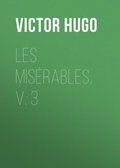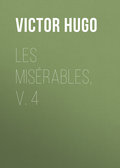
Виктор Мари Гюго
Ninety-Three
VIII
DOLOROSA
Meanwhile the mother was searching for her little ones, walking straight onward; and how she subsisted we cannot tell, since she did not know herself. She walked day and night, begging as she went, often living on herbs and sleeping upon the ground in the open air, among the bushes, under the stars, and sometimes mid the rain and the wind. Thus she wandered from village to village and from farm to farm, making inquiries as she went along, but, tattered and torn as she was, never venturing beyond the threshold. Sometimes she found a welcome, sometimes she was turned away; and when they refused to let her come in, she would go into the woods.
Unfamiliar as she was with the country beyond Siscoignard and the parish of Azé, and having nothing to serve as guide, she would retrace her steps, going over and over the same ground, thus wasting both time and strength. Sometimes she followed the highway, sometimes the cart-ruts, and then again she would turn into the paths in the woods. In this wandering life she had worn out her wretched garments. At first she had her shoes, then she went barefoot, and it was not long before her feet were bleeding.
Unconsciously she travelled on, mid bloodshed and warfare, neither hearing, seeing, nor trying to shield herself, simply looking for her children. As the entire country was in rebellion, there were no longer any gendarmes, or mayors, or authorities of any kind. Only such persons as she encountered on the way would she stop to ask.
"Have you seen three little children anywhere?"
And when the passers-by lifted their heads she would say, —
"Two boys and a girl," and go on to name them:
"René-Jean, Gros-Alain, Georgette. Have you not seen them?"
And again, —
"The oldest one was four and a half and the youngest twenty months."
Presently she would add, —
"Do you know where they are? They have been taken from me."
People gazed at her, and that was all.
Perceiving that she was not understood, she would explain, —
"It is because they are mine. That is the reason."
And then seeing the passers-by continue their way, she would stand speechless, tearing her breast with her nails. One day, however, a peasant stopped to listen to her. The worthy man set his wits at work.
"Let us see. Did you say three children?" he asked.
"Yes."
"Two boys?"
"And a girl."
"And you are looking for them?"
"Yes."
"I was told that a nobleman had carried off three little children and keeps them with him."
"Where is that man? Where are they?" she cried.
"Yon must go to the Tourgue," answered the peasant.
"And shall I find my children there?"
"Very likely you will."
"What did you say the name was?"
"The Tourgue."
"What is the Tourgue?"
"It is a place."
"Is it a village, a castle, or a farm?"
"I never was there."
"Is it far?"
"I should say so."
"In what direction?"
"In the direction of Fougères."
"Which way shall I go?"
"You are now at Ventortes," replied the peasant. "You will leave Ernée on your left and Coxelles on your right; you must pass through Longchamps, and cross the Leroux."
The peasant raised his hand and pointed westward.
"Keep straight ahead, facing the sunset."
She had already started before he had time to lower his arm.
He called out to her.
"You must be careful; they are fighting over there."
She never turned to reply, but walked straight ahead without pausing.
IX
A PROVINCIAL BASTILE
I
LA TOURGUE
The traveller who forty years ago entered the forest of Fougères from the direction of Laignelet and came out towards Parigné, might have beheld on the edge of this dense forest a sinister sight, for emerging from the thicket he would come directly upon the Tourgue, and not the living Tourgue, but the dead one.
The Tourgue cracked, battered, scarred, dismantled. A ruin may be called the ghost of an edifice. Nothing could be more lugubrious than the aspect of the Tourgue. A high circular tower stood alone like a malefactor on the edge of the wood, and rising as it did from a precipitous rock, its severe and solid architecture gave it the appearance of a Roman structure, combining within itself the elements of power and of decay. In fact, it might in one sense be called Roman, since it was Romance. It was begun in the ninth century and finished in the twelfth, after the time of the third crusade. The style of the imposts of its embrasures indicated its period. If one approached it and cared to climb the slope, he might perceive a breach in the wall; and if he ventured to enter in, he would find a vacant space and nothing more. It was not unlike the inside of a stone trumpet set upright on the ground. From top to bottom there were no partitions, and neither ceilings nor floors; here and there arches and chimneys had evidently been torn away, and falconet embrasures were still seen; at different heights, rows of granite corbels and a few cross-beams covered with the ordure of the night birds marked the separate stories; a colossal wall, fifteen feet thick at its base and twelve at its summit; cracks here and there, and holes which once were doors, and through which one caught glimpses of staircases within the gloomy walls. One who passing by at evening might venture in, would hear the cry of the wood-owl, the goat-suckers, and the night-herons; would find brambles, stones, and reptiles beneath his feet; and overhead, through a dark circular opening at the top of the tower which looked like the mouth of an enormous well, he might see the stars.
Local tradition relates that there were secret doors in the upper stories of this tower, like those in the tombs of the kings of Judah, composed of one large stone turning on a pivot, which when closed could not be distinguished from the wall itself, – a fashion in architecture brought home by the crusaders, together with the pointed arch. When these doors were closed, it was impossible to discover them, so skilfully were they fitted into the rest of the stones. Such doors can be found to-day in those mysterious Libyan cities which escaped the earthquakes that buried the twelve cities in the time of Tiberius.
II
THE BREACH
The breach by which one gained access to the ruin was the opening of a mine. A connoisseur familiar with Errard, Sardi, and Pagan would have appreciated the skill with which this mine was planned. The fire-chamber, in the shape of a biretta, was of a size accurately proportioned to the strength of the keep which it was intended to destroy. It was capable of containing at least two hundred-weight of powder. The winding passage which led to it was more effective than a straight one. The saucisse, laid bare among the broken stones as the result of the crumbling caused by the mine, was seen to have the requisite diameter of a hen's-egg. The explosion had made a deep rent in the wall, by which the assailants were enabled to enter. It was evident that this tower must have sustained formal sieges from time to time. It was riddled with balls, and these were not all of the same epoch; every missile has its own special way of marking a rampart, and each one, from the stone bullets of the fourteenth century to the iron ones of the eighteenth, had left a scar upon this donjon-keep.
The breach opened into what must have been the ground-floor; and directly opposite, in the wall of the tower, was the gateway of a crypt, cut in the rock and extending under the hall of the lower floor throughout the foundation of the tower.
This crypt, three-fourths filled up, was cleared out in 1835, under the direction of Auguste Le Provost, the antiquary of Bernay.
III
THE OUBLIETTE
This crypt was the oubliette. Every keep possessed one, and this, like many other penal dungeons of the same period, had two stories. The first story, accessible through the gate, consisted of a good-sized vaulted chamber, on a level with the hall of the ground-floor. On the walls of this room might be seen two vertical furrows, parallel with each other, reaching from wall to wall and passing along the vault, where they had left a deep rut, reminding one of wheel-tracks, – and such in fact they were; for these two furrows were hollowed out by two wheels. In old feudal times men had been torn limb from limb here in this very room, by a process less noisy than that of being drawn and quartered. They had a pair of wheels so large and powerful that they filled the entire room, touching both walls and ceiling, and to each wheel was attached an arm and a leg of the victim; and when these wheels were turned in opposite directions, the man was torn asunder. It required great power; hence the ruts worn in the stone by the grazing of the wheels. A room of this kind may be seen at Vianden.
Above this room there was another, the actual oubliette, whose only entrance was a hole which served the purpose of a door; the victim, stripped of his clothes, was let down, by means of a rope tied under his armpits, into the room below, through an opening made in the middle of the flagging of the upper room. If he persisted in living, food was thrown to him through this aperture. A similar hole may still be seen at Bouillon.
This chamber below, excavated under the hall of the ground-floor to such a depth that it reached water, and constantly swept by an icy wind, was more like a well than a room. But the wind so fatal to the prisoner in the depths was, on the other hand, favorable to the one overhead, groping about beneath the vault, who could breathe the easier on account of it; indeed, all the air he had, came up through this hole. But then any man who entered, or rather fell, into this tomb, never came out again. It behooved the prisoner to look out for himself in the darkness, for it needed but one false step to change the scene of his sufferings. That, however, was his own affair. If he were tenacious of life, this hole was his danger; but if he were weary of it, it was his resource. The upper story was the dungeon, the lower one the tomb, – a superposition not unlike that of the society of the period.
This is what our ancestors called a moat-dungeon; but since the thing itself has disappeared, the name has no longer any meaning for us. Thanks to the Revolution, we can listen with indifference to the sound of these words. On the outside of the tower, and above the breach, which forty years ago was its only entrance, might be seen an embrasure somewhat wider than the other loopholes, from which hung an iron grating, loosened and broken.
IV
THE BRIDGE-CASTLE
A stone bridge whose three arches were but slightly damaged, was connected with this tower on the side opposite to the breach. This bridge had once supported a building whose few remaining fragments bore the traces of a conflagration; it was only the framework that was left standing, and as the light shone through its interstices as it rose side by side with the tower, it had the effect of a skeleton beside a phantom.
To-day this ruin is utterly demolished, leaving no trace whatever behind. A single peasant can destroy in one day structures that kings have labored for centuries to erect. La Tourgue, a peasant abbreviation, signifies La Tour-Gauvain, just as La Jupelle stands for La Jupellière, and Pinson le Tort, the name of a hunchback leader, for Pinson le Tortu.
La Tourgue, which even forty years ago was a ruin, and which to-day is but a shadow, was a fortress in 1793. It was the old Bastile of the Gauvains, and served to guard, towards the west, the entrance of the forest of Fougères, which is now little more than a grove.
This fortress was built on one of those great blocks of slate which are found in abundance between Mayence and Dinan, scattered in all directions among the copses and along the heath like the missiles of some Titanic combat. The tower composed the entire fortress; and below the tower stood the rock at whose base flowed one of those water-courses which swells into a torrent in January and dries up in June.
Simple as were its means of defence, this tower was almost impregnable in the Middle Ages, but the bridge had proved a source of weakness. The Gauvains of Gothic times had built it without a bridge. It was formerly accessible by means of one of those swinging bridges that could be instantly severed by the stroke of an axe. So long as the Gauvains remained Viscounts it pleased them just as it was, and they were satisfied with it. But when they became Marquises and exchanged the keep for the Court, they spanned the stream with three arches and thus offered access in the direction of the plain very much as they had yielded to the advances of the king. The marquises of the seventeenth century and the marchionesses of the seventeenth no longer prided themselves on their impregnability. They abandoned the traditions of their ancestors to follow the fashions of Versailles.
Facing the tower towards the west was a somewhat elevated plateau adjoining two plains; this plateau was very near the tower, only separated from it by a deep ravine through which flowed a stream tributary to the Couesnon. The bridge that connected the fortress with the plateau stood on lofty piles, and on these piles was constructed as at Chenonceaux a building in the Mansard style of architecture, but more comfortable than the tower. Customs were still very rude, and the lords continued to occupy chambers in the keep that were more like dungeons than bedrooms. As to the building on the bridge, which was a diminutive kind of castle, a long corridor had been added to it, by way of entrance, which was called the hall of the guards. Over this hall, which was like an entresol, was the library, and above that a granary. Separated by pillars stood the long windows with their small panes of Bohemian glass; medallions were sculptured on the walls. The fortress was three stories high; halberds and muskets were to be found below, books in the middle, and over all the bags of oats, – a somewhat barbarous arrangement, but princely to the last degree.
The tower loomed above this coquettish building presenting a stern and gloomy contrast.
The platform offered a point of attack from which the bridge could be destroyed.
Between these two buildings there was no harmony whatsoever; the roughness of the one jarred against the elegance of the other. It would seem as if two semicircles ought to be identical; yet no two styles have less in common than that of a Roman semicircle and a classic archivolt. That tower, a worthy companion for the forest, was a strange neighbor for the bridge, which might have come from Versailles. Fancy Louis XIV. leaning on the arm of Alain Barbe-Torte. There was something appalling in this juxtaposition. An inexpressible spirit of terror pervaded the combined majesty of these structures.
Let us repeat, that from a military point of view the bridge went far towards betraying the tower; for while it added to its beauty it diminished its strength, ornamenting it on the one hand and weakening it on the other; by placing it on a level with the plateau, it had exposed it to attacks from that direction, although it still remained impregnable in the direction of the forest. Formerly it had commanded the plateau, but matters were now reversed. An enemy installed on the plain would speedily become master of the bridge. The library and the granary were advantageous to the besiegers rather than to the besieged, since the contents of both are of a combustible nature. For an assailant who knows how to avail himself of fire as a means of assault, it matters but little whether it be a Homer or a bundle of hay, provided it burns. The French offered a proof of this fact to the Germans when they burned the library at Heidelberg, as did the Germans in burning that of Strasbourg. In short, this bridge built on to the Tourgue was a strategic mistake; but in the seventeenth century, under Colbert and Louvois, the Princes Gauvain, like the Princes de Rohan or La Tremoille, believed themselves henceforth safe from assault. Still, the builders of the bridge had taken certain precautions. In the first place, anticipating the chances of fire, they had fastened crosswise below the three windows looking towards the stream, by iron clamps which no longer than fifty years ago were still to be seen, a strong ladder, equal in length to the height of the first two stories of the bridge, – a height surpassing that of three ordinary stories; secondly, foreseeing the possibility of a siege, they had isolated the bridge from the tower by means of a low and heavy iron door, arched at the top and locked with a large key, whose hiding-place was known to the master alone; once closed, it could defy the battering-ram and almost brave the cannon-ball.
One must cross the bridge to reach this door, which was the only means of access to the tower.
V
THE IRON DOOR
As a result of the elevation of this castle on the bridge by means of piles, its second story was on a level with the corresponding story of the tower; and here, for greater safety, the iron door had been placed.
This iron door led from the bridge into the library, and from the tower into a large vaulted hall with a pillar in the centre. As already stated, this hall was in the second story of the keep. Like the tower itself, it was circular in its form, and was lighted by deep embrasures overlooking the fields. The stones of its rough and naked walls, unhidden from the view, were, however, symmetrically adjusted. This hall was reached by a spiral staircase built in the wall, – quite a simple matter when walls are fifteen feet thick. In the Middle Ages they used to capture a city by streets, a street by houses, and a house by rooms; and thus a fortress was besieged story by story. In this respect La Tourgue was very skilfully arranged, and very difficult to cope with. An uncomfortable staircase connected one story with another; the doors were sloping, and not high enough to admit a man unless he bent his head; and where at every door the besieged stood in waiting for their assailants, a bowed head was certain death.
Below the circular hall with the pillar were two similar rooms, composing the first story and the ground-floor, and above these three more. The tower was closed, so to speak, by a platform which rested on these six rooms like a stone cover, and a narrow watch-tower led up to the platform.
As they were obliged to pierce this wall in which the iron door was sealed to a depth of fifteen feet, it was thereby framed in a deep archway, which when the door was closed formed a porch six or seven feet deep, towards the bridge as well as towards the tower, and when it was open these two porches united to form the entrance arch. Set in the wall under the porch, towards the bridge, was a low gate with a Saint-Gilles bolt, leading into the corridor of the first story under the library. This was another difficulty for the besiegers. That side of the castle on the bridge looking towards the plateau ended in a perpendicular wall, and there the bridge was severed. The drawbridge set up against a low gate to connect it with the plateau, and which on account of the height of the latter could only be lowered like an inclined plane, led into the long corridor called the guard-room. The besiegers who found themselves in possession of this corridor would have been obliged to carry by main force the Saint-Gilles winding stairway that led to the second story, in order to reach the iron gate.
VI
THE LIBRARY
As to the library, it was an oblong room of the same length and width as the bridge, with a single door, and that the iron one. A false folding-door covered with green cloth, which only needed to be pushed, concealed within the entrance arch of the tower. The walls of the library were lined from floor to ceiling with glass bookcases in the fine taste of the seventeenth century cabinet-work, and lighted by six large windows, three on a side, – that is, one over each arch. Through these windows the interior of the room was visible from the height of the platform. Between the windows stood six marble busts on pedestals of carved oak, – Hermolaüs of Byzantium, the grammarian Athenæus of Naucratis, Suidas, Casaubon, Clovis, King of France, and his chancellor, Anachalus, – who for that matter was no more a chancellor than Clovis was a king.
There were various books in the library. One has remained famous. It was an ancient quarto, enriched with prints, with the title "Saint Bartholomew" in large letters, together with the sub-title, "Gospel according to Saint Bartholomew, preceded by a dissertation by Pantoenus, Christian philosopher, on the question as to whether this Gospel should be considered apocryphal, and whether Saint Bartholomew is identical with Nathanal." This book, supposed to be a unique copy, was placed on a reading-desk in the middle of the library. In the last century people came to see it as a curiosity.







